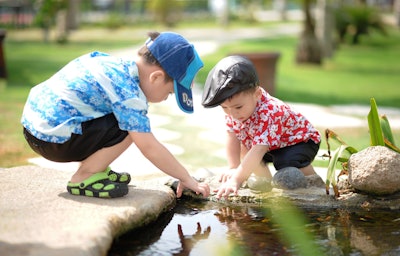
So much play time has been boxed into structured, organized activities that children no longer see how nature works and become afraid of it, says Jeff Charlesworth, director of design for landscape architecture firm Back to Nature in Oldwick, New Jersey. Recognizing this, most of his clients are looking for anything that will lure their children outdoors. “The more kids can explore and figure out for themselves, the more comfortable they’ll be with nature,” Charlesworth says.
The days of playing independently – something critical to child development – are disappearing, agrees Marc Leathers, president of Leathers & Associates, which has designed custom playgrounds in all 50 states and seven other countries. But creating well-designed spaces can help reverse the trend. “I think it’s up to everybody – parents, landscapers, communities – to think it through and look for creative solutions,” Leathers says.
Learn what children want
Those solutions hinge on getting input from children. While interviewing a 6-year-old might feel odd, learning about those who will be using the spaces you design – the same way you do with adult clients – only makes sense. “Their [children’s] ideas, their judgment, their dreams are what it’s all about,” Leathers says.
Back to Nature personnel have spent days with students at two private schools in an effort to find out what they would like to see and do outside. For residential projects, design staff members include children when interviewing homeowners and take their interests into account when analyzing properties.
Beyond swing sets
Play areas don’t have to be limited to traditional equipment in a corner of the backyard
“We find that kids just love to play in nature,” Charlesworth says. “In a lot of ways there is very little to set up.” At the Willow School in Gladstone, New Jersey, for example, large boulders children wanted for climbing purposes were easy to find. The school is designed around a woodland core, and while there is a playground, kids also explore natural areas, using sticks and other things they find to build tepees and art projects.
Vicki Stoecklin, education and child development director for White Hutchinson Leisure & Learning Group, which designs play areas, suggests providing informal spaces where kids can use their imaginations and manipulate and experiment with the environment using natural materials. Interactive water play, for instance, can be part of a bog or stream habitat, she says.
Because children enjoy watching plants grow and learning about wildlife, the landscape itself can be a play setting. Charlesworth suggests providing plants with flowers and berries that attract birds and butterflies throughout the year. A water source such as a bird bath or fountain also can attract animals, and ponds offer an opportunity for kids to learn how fish and aquatic plants function in an ecosystem.
Vegetable and fruit gardens are extremely popular among Charlesworth’s clients who have children. Parents like gardens for two reasons: they provide recreation and fill a need for education. “Everyone is interested in having their kids understand where food comes from,” Charlesworth says. “They want them to know apples don’t come from a grocery store; they come from trees.”
Unique playgrounds
Of course kids love structures designed just for them as well.
In recent years, there’s been a trend toward more climbing structures such as cable nets and fewer decks, Leathers says. His company is working to design structures where kids “basically climb through the entire playground.”
Both Leathers and Charlesworth say their companies avoid the brightly colored plastic look of manufactured play equipment. Charlesworth’s firm opts for local wood products, and if trees at a site have to be cut, will use those.
Leathers says his company started out building all-wood playgrounds, and he still prefers the natural appearance. But his firm transitioned gradually to a combination of wood and plastic composite materials and now builds some all-plastic playgrounds. Plastic composites have evolved to the point it’s difficult to distinguish them from wood, he says. “You’re getting all the benefits of the lower maintenance and durability of plastic and the design benefits of wood,” he says.
Children provide inspiration for the unique playgrounds Leathers’ company designs. But tapping their imaginations takes a little digging. They’ve been programmed to think of catalog-type basics such as swings and slides, and will ask for those first, Leathers says. While those elements are incorporated into the structure, the company is looking for a creative theme. So the designer asks, “But if you could have anything you want?”
“Then they start slowly to say things like, “I want an octopus coming out of the ocean,” Leathers says. For a playground in California, one child asked for a “robot farmer.” Leathers’ company created a boxy, machine-looking figure wearing a straw hat and surrounded by a farm scene. Kids climb a vertical ladder inside the robot farmer to an observation deck.
Charlesworth says the boys his company interviews usually ask for forts or tree houses, while the girls ask for playhouses. Back to Nature designs structures versatile enough for children to interpret as boats, airplanes, houses, forts or spaceships. “For the same child, it could be one thing one day, another the next day; or different depending on the group of children using it,” Charlesworth says. “We’re always amazed how children can project their imaginations on these things.”







